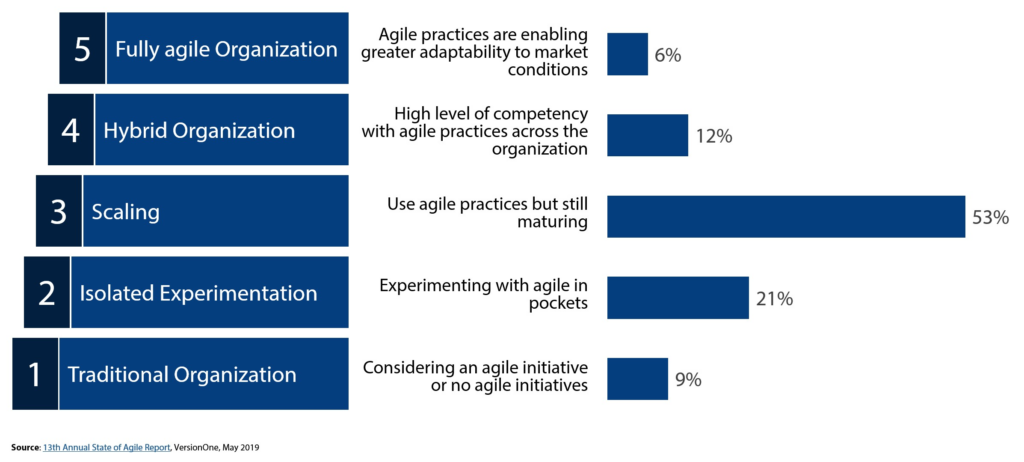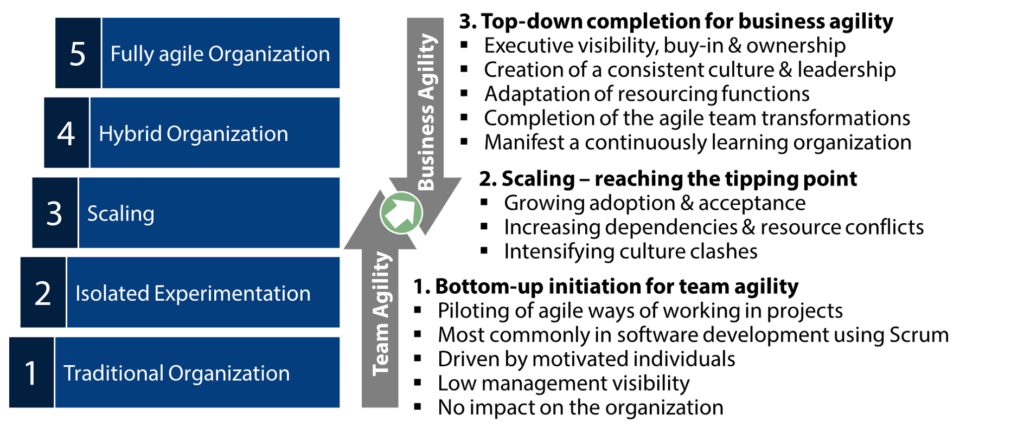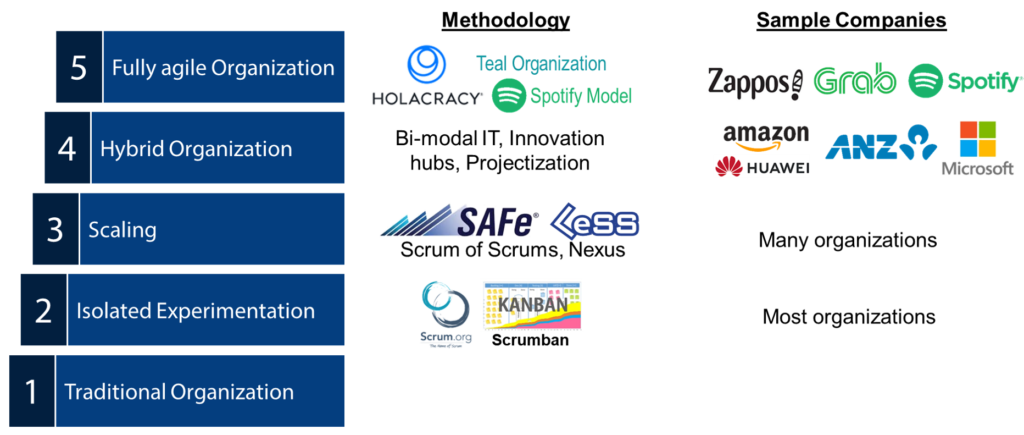Few organizations are born agile and may look back to times when agile was only used to describe athletes. For them, achieving business agility is a journey that leads them through various stages. The Agility Steps Model provides a simple illustration of those stages.
Step 1 – Traditional Organization
Initially, on Step 1, organizations have not been exposed to agile ways of working. The organization is run based on clear organizational hierarchies, roles and processes. Vertical silos dominate while the organization focuses mostly on efficiency. Customer orientation and the ability to learn and change are low.
Step 2 – Isolated Experimentation
As the need for agility, the availability of agile practices, and market adoption of agile increases organizations take note and become interested. Early adopters in an organization start to use agile ways work working. Individual teams adopt agile based on their own initiative to increase results and customer value.
Most commonly, isolated experimentation starts in IT with software development and Scrum. This is where the maturity and value proposition are high.
Early experiments with agile are often encapsulated in projects and have low visibility to, interaction with, and impact on other parts of the business. We know executives that were amazed to find out that their organizations are already using agile.
Step 3 – Scaling
As the use of agile starts to show its positive effect on business outcomes more people take note. As IT projects deliver superior results, complete below budget, and early other teams start to adopt agile. As business people are involved as product owners in agile teams they wonder how agile could help their own teams to become more successful. Knowledge, interest and acceptance of agile is spreading. Agile moves from IT to the business and temporary projects to permanent teams.
At this point agile is viral. Its obvious benefits in the pilot situations, quick wins and its positive effect on staff engagement and happiness drives this.
But the agile fire burns quickly and runs out of fuel as the areas where it is welcome and its benefits are obvious are covered.
The agile virus increasingly meets people who are immune against it and the agile fire starts to burn against solid rock and fails to cross the chasm between early adopters and early majority.

This is the most critical time in the journey to an agile organization. As they start to struggle the agile movement looses steam. Most organization get stuck there for a while. The global agile survey by VersionOne from 2019 sees 53% of organizations there:

As the agile movement gets challenged a tipping point is reached where things can move into two directions: agile looses steam and retreats back to the isolated parts of the organization where it came from or it gets a push and manages to overcome the hurdles.
To overcome the hurdles the agile transformation needs to make a fundamental shift: it needs to evolve from a bottom-up to a top-down initiatives, from a project/team-based initiative to a business-wide initiative.

Such an organization-wide agile transformation takes a broad and long-term perspective with the objective of establishing business agility. It typically has the following characteristics:
- Strong top-down executive visibility, buy-in and ownership.
- Establishment of a common agile culture and leadership across the entire organization.
- Adaptation of corporate functions for resourcing (people, money, materials) and decision-making (central vs. de-central) to better support agile ways of working.
- Adoption of an structured approach to identify and implement agile in all areas where it is needed from a business perspective with the objective to complete the transformations of those teams to agile.
- Manifesting continuous learning on an organizational level.
Overall, the shift from bottom-up to top-down implementation aims at making the shift to agile permanent and irreversible and is executed in form of an agile transformation.
Towards the later phases of Step 3 the organization will start to understand what agile can really do for it and what it cannot, where and how it can drive better business results and where the proven ways of working should remain.
The organization develops a balanced, educated view about agile. A stable, hybrid organization starts to form.
Step 4 – Hybrid Organization
Most organizations that have implemented agile ways of working for a while have reached this stage. Their agile practices have matured and individualized to a unique combination optimized for business results.
Agile businesses like Amazon, Apple, and Google struggle with describing their individual approaches with known labels like ‘Scrum’ or ‘SAFe’. For them it’s the “Google way” or “Apple way”. Agile ways for working are second nature for them.
This is why at Step 4 there are no established agile methodologies. At this level, agile is highly individual.

As an hybrid organization, Amazon has agile development teams in AWS and traditional warehousing organizations. Microsoft develops software exclusively agile but runs its sales & marketing organization the old way.
They have reached a stable balance of agile and proven ways of working that optimizes business performance, results and success. Those organizations could probably thrive as hybrid organizations forever. As learning organizations they will recognize the need to re-adjust the balance as required.
However, some may choose to go further and transform to 100% agile.
Step 5 – Fully agile Organization
Businesses at this step are mostly companies who are ‘born agile’ like Netflix, Grab or Spotify.
Zappos is an example for a company that decided in 2015 to implement Holacracy and go 100% agile.
Companies at this step rarely have more than 5,000 employees and there are also signs of growing pains that may indicate that this might not be a suitable model for larger organizations at the moment.
However, over-time, new organizational models may evolve that make larger self-organizing businesses feasible. And existing fully-agile businesses that grow further will provide more insights.
At the moment, for normal businesses, achieving a balanced and stable hybrid state seems to be the better objective. This is what the My Business Agility Framework is built for.
